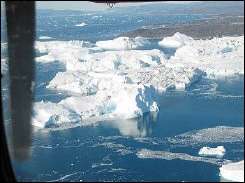Iceberg crashes into Drygalski Ice Tongue

An iceberg, C-16, rammed into the Drygalski Ice Tongue, a large sheet of glacial ice in Antarctica, breaking off a huge block and forming a new iceberg.
The floating Drygalski Ice Tongue, which protrudes almost 50 miles into the ocean, is connected to the David Glacier. If it were to break loose, scientists fear it could alter ocean currents, changing the region's climate, the European Space Agency said.
"The surface ocean currents appear to have predominantly steered the iceberg, not the winds, thus telling us about important aspects of the adjustment in the ocean circulation since the departure of large grounded icebergs off Ross Island," said Mark Drinkwater of ESA's Ocean and Ice Unit.
ESA's Envisat satellite Advanced Synthetic Aperture Radar shows images of the iceberg and the ice tongue before and after the collision. The collision on March 30 shows the ice tongue breaking off, and the final image on April 1 captures C-16 and the new iceberg swinging to the other side of the ice tongue.
Copyright 2006 by United Press International



















